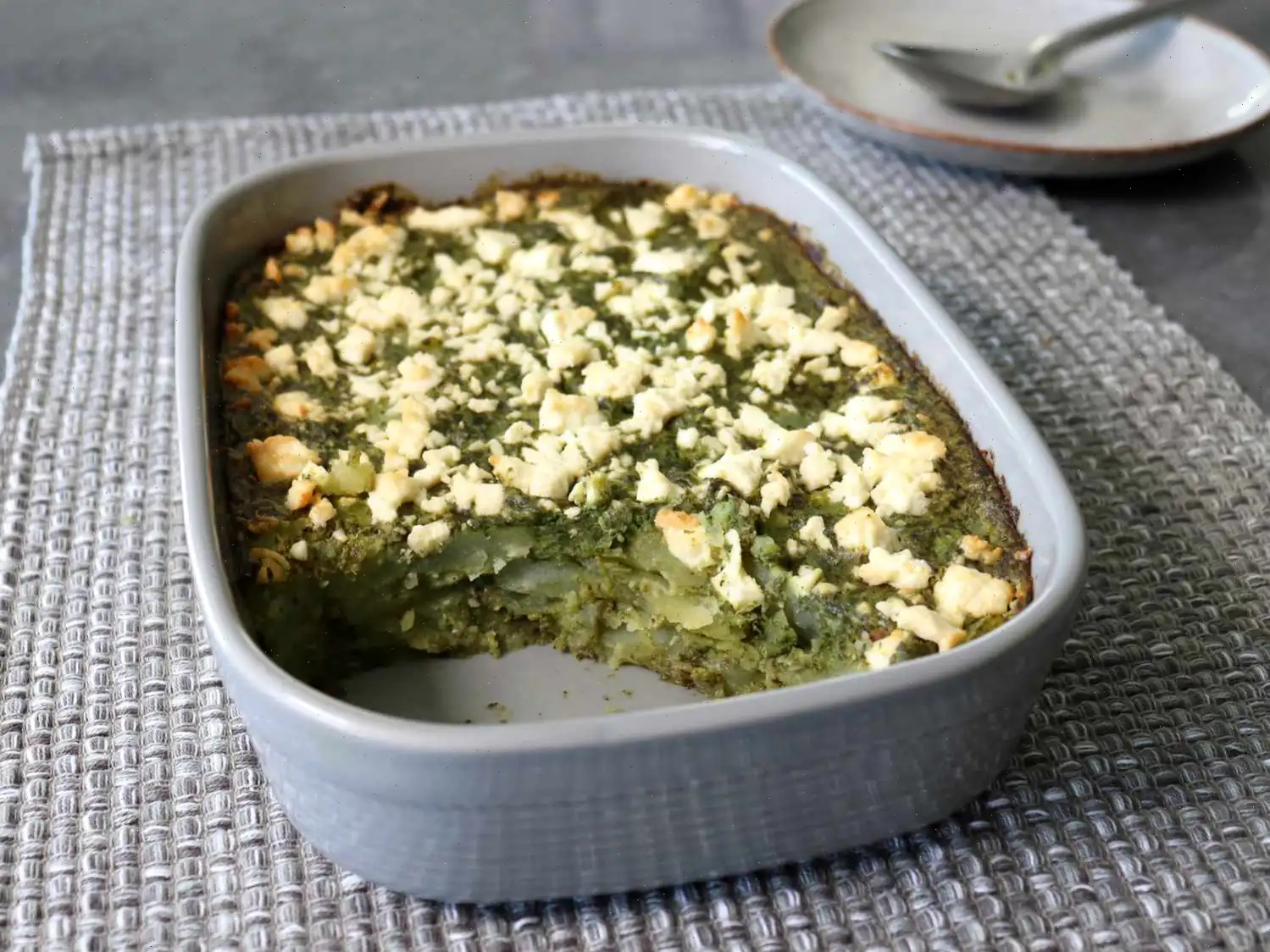
Greek Feta and Spinach Potato Casserole Recipe
This Greek-inspired feta and spinach potato casserole combines creamy potatoes with the vibrant flavors of spinach, feta, and olive oil, creating a dish that is rich in flavor without being overly decadent. The perfect balance of savory and fresh, this casserole is simple yet satisfying. Here's how to make it.
Ingredients:
- 2 1/2 pounds Yukon Gold potatoes, peeled and halved
- 8 ounces spinach
- 2 tablespoons water
- 1/4 cup extra virgin olive oil
- 2 cloves garlic, peeled
- 2 tablespoons sliced green onions
- 2 teaspoons lemon zest
- 1 1/2 teaspoons kosher salt (to taste)
- 1/2 teaspoon freshly ground black pepper (to taste)
- Cayenne pepper (to taste)
- 1 large egg
- 6 ounces Greek feta, crumbled, divided
- 1/4 cup fresh mint leaves
Directions:
Step 1: Start by placing the potatoes in a large pot and covering them with salted water. Bring the water to a boil, then reduce the heat to medium-low. Let the potatoes simmer for about 15 minutes or until they are barely tender. Drain the potatoes and allow them to cool to room temperature.
Step 2: While the potatoes are cooling, prepare the spinach. Place the spinach in a dry saucepan over medium-high heat. Stir constantly with tongs to ensure the spinach wilts evenly without burning. This should take about 1 to 2 minutes. Once wilted, transfer the spinach to a high .
Step 3: To the spinach, add 2 tablespoons of water, 1/4 cup olive oil, the garlic cloves, green onions, lemon zest, salt, black pepper, cayenne pepper, the egg, half of the crumbled feta, and the mint leaves. Use an immersion blender to puree everything until smooth and well combined.
Step 4: Preheat your oven to 400F (200C). While the oven is heating, slice the cooled potatoes into 1/4-inch thick slices and place them in a large bowl.
Step 5: Pour the spinach mixture over the sliced potatoes and toss gently to coat each slice evenly. Make sure every potato slice is coated with the spinach mixture for maximum flavor.
Step 6: Transfer the potato and spinach mixture to a shallow baking dish. Smooth the top and sprinkle the remaining feta cheese over the surface.
Step 7: Place the dish on the center rack of the preheated oven. Bake for 35 to 45 minutes, or until the edges of the feta start to turn golden and crispy. The casserole should be bubbly and fragrant.
Step 8: Once done, remove from the oven and let it rest for about 10 minutes before serving. This allows the flavors to settle and the casserole to firm up for easy slicing.
Nutrition Facts (per serving):
- Calories: 360
- Total Fat: 16g (21% DV)
- Saturated Fat: 6g (29% DV)
- Cholesterol: 56mg (19% DV)
- Sodium: 633mg (28% DV)
- Total Carbohydrate: 45g (16% DV)
- Dietary Fiber: 5g (19% DV)
- Total Sugars: 5g
- Protein: 11g (22% DV)
- Vitamin C: 24mg (26% DV)
- Calcium: 230mg (18% DV)
- Iron: 4mg (21% DV)
- Potassium: 1236mg (26% DV)
Note: Percent Daily Values are based on a 2,000-calorie diet. Your daily values may be higher or lower depending on your calorie needs.
The Origins of Greek Feta and Spinach Potato Casserole
The Greek Feta and Spinach Potato Casserole is a modern twist on traditional Greek comfort food, inspired by the classic spanakopita and potato gratins. While spanakopita dates back centuries in Greece, featuring layers of phyllo dough, spinach, and feta, this casserole simplifies the dish by substituting potatoes for the pastry, making it heartier and more approachable for everyday meals. Its roots lie in the Mediterranean emphasis on fresh vegetables, olive oil, and cheese, hallmarks of Greek home cooking that have been passed down through generations.
Regional Variations
Across Greece, regional adaptations of spinach and cheese dishes exist. In northern Greece, creamy feta is often paired with herbs such as dill and parsley, while in the Cyclades islands, mint and lemon zest are popular additions. The casserole version of this dish typically uses Yukon gold or similar waxy potatoes, which absorb flavors more readily, creating a moist, cohesive bake. Some coastal regions may incorporate seafood or local cheeses to diversify the dish, but the essential combination of spinach, feta, and olive oil remains constant.
How It Differs From Similar Dishes
Unlike traditional potato gratins, which rely on heavy cream and cheese for richness, this Greek-inspired casserole integrates spinach and mint, giving it a lighter, more herbaceous character. Compared to spanakopita, it omits phyllo dough entirely, resulting in a dish with a creamy interior and subtly crisp top from baked feta. The combination of potatoes and a spinach-feta puree creates a unique texture that bridges the gap between a gratin and a vegetable casserole.
Typical Serving Occasions
This casserole is versatile and can be served as a main dish for a light lunch or as a side dish during dinner parties or festive gatherings. It pairs beautifully with grilled meats, roasted fish, or a fresh Greek salad. In Greek households, casseroles like this are often prepared for family meals, offering a comforting, flavorful addition to the table that showcases the regions love of fresh produce and simple, bold flavors.
Interesting Facts
- The dish highlights feta cheese, a staple in Greek cuisine, which has been produced in the country for over 2,500 years.
- Mint is traditionally used in Greek cooking not just for flavor but also for its digestive properties, making this casserole a refreshing yet hearty dish.
- The use of Yukon gold potatoes is intentional; their creamy texture holds up well during baking, unlike starchy varieties that can become mushy.
- This casserole is sometimes referred to as a spanakorizo-inspired potato bake, reflecting its conceptual link to spinach and rice dishes in Greek culinary tradition.
- While modern adaptations often incorporate immersion blenders for a smooth filling, older recipes relied on hand-chopping and mixing, giving a chunkier, rustic texture.
In essence, the Greek Feta and Spinach Potato Casserole combines tradition and innovation, turning familiar Mediterranean flavors into a comforting, easy-to-make dish perfect for any occasion.
You can listen to this recipe in AI audio format. Simply click the play button below to listen to the content in a format that suits you best. It’s a great way to absorb information on the go!
FAQ about Greek Feta and Spinach Potato Casserole Recipe
Comments
Thomas Gomez
09/30/2024 09:10:15 AM
Wilting the spinach with my tongue was painful and felt quite unhygienic, so I switched to tongs. Other than that, the dish was amazing.
Dennis Flores
06/03/2023 04:22:52 AM
Wow, this dish is absolutely amazing! It's so flavorful and delicious. I used my freshly harvested garlic, which is young and packed with strong flavor. The cloves are large, so I only needed to use one, and the garlic really shines through. I will definitely be making this dish over and over again. Thank you, Chef John, for never failing to impress me.
Virginia Garcia
05/03/2024 12:57:15 PM
I have made this recipe three times already. I always use frozen spinach but skip adding the extra water. It freezes well and reheats nicely too. One time I forgot to get feta cheese, so I used a mix of different cheeses instead. It still tasted fantastic!
Jessica King
05/19/2023 02:46:50 PM
I opted for frozen spinach in this recipe, and the end result was absolutely delightful. The addition of mint provided a unique and intriguing flavor profile.
Helen Phillips
03/07/2025 04:33:01 PM
Great recipe! I didn't have fresh spinach on hand, so I substituted with frozen and it turned out wonderfully. This dish is incredibly delicious.








